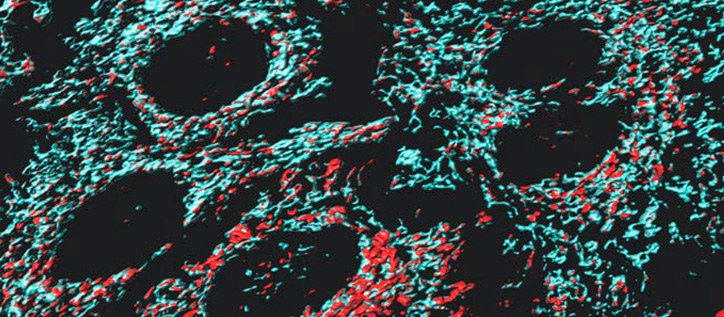Out with the old: mitochondrial quality control protein identified
Osamu Yamaguchi, Associate Professor, Graduate School of Medicine/ Yasushi Sakata, Professor, Graduate School of Medicine
The protein responsible for the disposal of aging mitochondria in humans has been revealed, with important implications for heart and neurodegenerative diseases

Credit: HeitiPaves/iStock/Thinkstock
Caption: Mitochondria (black ovals) need to be regularly replenished to power essential cellular processes. The protein responsible for initiating this mitochondrial turnover has been discovered in humans.
Out with the old: mitochondrial quality control protein identified
The protein responsible for the disposal of aging mitochondria in humans has been revealed, with important implications for heart and neurodegenerative diseases
The protein that initiates the destruction of old and diseased mitochondria ― small, cellular ‘power plants’ ― has been identified for the first time by researchers at Osaka University and King’s College London[1]. Malfunctions in clearing damaged mitochondria are implicated in a number of disorders, including metabolic diseases, heart failure, and debilitating neurodegenerative diseases such as Alzheimer’s and Parkinson’s.
Mitochondria power the essential cellular processes that keep us healthy, but old and diseased mitochondria release reactive molecules that can damage cellular proteins and DNA. In normal cells, these damaged mitochondria are broken into small pieces (mitochondrial fragmentation) and gobbled up by killer vesicles (mitophagy) so that they can be replaced with fresher mitochondria. When the processes of mitochondrial quality control go wrong, very serious and often life-threating complications arise.
Scientists have known for some time that the protein Atg32 is essential for mitophagy in yeast, but have been unable to track down its functional equivalent in humans and other mammals. Osamu Yamaguchi, Yasushi Sakata and co-workers at the Department of Cardiovascular Medicine in Osaka University, with collaborators elsewhere in Japan and Kinya Otsu, a professor of cardiology at King’s College in the United Kingdom, have identified the functionally equivalent protein of Atg32 in mammals, called Bcl-2-like protein 13 (Bcl2-L-13).
Previous attempts had largely relied on searching for proteins in human cells that have similar amino acid sequences to Atg32. Yamaguchi and co-workers adopted a different tactic of basing their search on the molecular features of Atg32. By screening a public database for proteins with similar features, they uncovered Bcl2-L-13, a transmembrane protein found in the mitochondria that shares amino acid structural arrangements with Atg32. Unsurprisingly, the amino acid sequence of Bcl2-L-13 had little in common with that of Atg32.
The researchers confirmed the role of Bcl2-L-13 in mitochondrial destruction through cell culture experiments. They found that blocking the expression of Bcl2-L-13 in human embryonic kidney cells reduced mitochondrial fragmentation and mitophagy of damaged mitochondria. Furthermore, introducing Bcl2-L-13 to yeast cells deficient in Atg32 induced mitophagy.
Their finding is a major step in the fight against diseases associated with the persistence of damaged mitochondria. Yamaguchi says: “If we can efficiently eliminate abnormal mitochondria by mitophagy via controlling the activity of Bcl2-L-13, we will be able to intervene in such diseases.”
The team now intends to discover how Bcl2-L-13 is activated and functions in the body.

Osamu Yamaguchi, Associate Professor
Department of Cardiovascular Medicine, Graduate School of Medicine
http://www.med.osaka-u.ac.jp/index-e.html
yamaguti@cardiology.med.osaka-u.ac.jp

Yasushi Sakata, Professor
Department of Cardiovascular Medicine, Graduate School of Medicine
http://www.med.osaka-u.ac.jp/index-e.html
yasushisk@cardiology.med.osaka-u.ac.jp
Reference:
1. Murakawa, T., Yamaguchi, O., Hashimoto, A., Hikoso, S., Takeda, T., Oka, T., Yasui, H., Ueda, H., Akazawa, Y., Nakayama, H. et al. Bcl-2-like protein 13 is a mammalian Atg32 homologue that mediates mitophagy and mitochondrial fragmentation. Nature Communications 6, 7527 (2015).
DOI: http://dx.doi.org/10.1038/ncomms8527
This research project was supported by the Osaka University International Joint Research Promotion Program, which aims to further enhance research quality and promote globalization at Osaka University through advanced research with overseas collaborators. Yamaguchi and Sakata jointly conducted this research with the following researchers: Professor Kinya Otsu, King’s College London, United Kingdom
Interview held in March 2016
